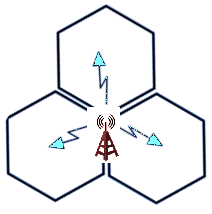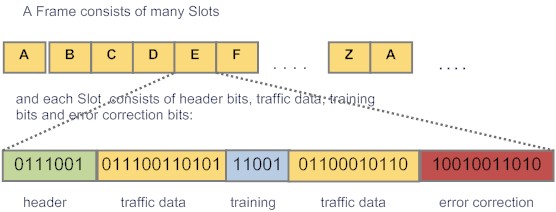 Section
Navigation
Section
Navigation
7. Technical Aspects
:Fundamental
7.1 Anatomy of Internet
7.2 Telecommunications
7.3 Wireless systems
7.4 Client Computers
7.5 Mobile Devices
7.6 Operating Systems
7.7 Computer Programs
7.8 Security: Applications
7.9 Browsers
7.10 Business Intelligence Systems
7.11 Cloud Computing
7.12 Databases
7.13 DTP Programs
7.14 eBook Readers
7.15 eMail Services
7.16 Expert Systems
7.17 Graphics Programs
7.18 Internet TV
7.19 Music & Video
7.20 Really Simple Syndication
7.21 Rich Media
7.22 Search Engines
7.23 Spreadsheets
7.24 Video Conferencing
7.25 Word Processing
:Corporate Matters
7.26 Cluster Analysis
7.27 Neural Networks
7.28 Pricing Models
7.29 Realtime Systems
7.30 Regression Analysis
 7.3
Wireless Systems
7.3
Wireless Systems
Satellites provide an important link in the Internet, and wireless transmission
enables phones and similar mobile devices. Transmission Protocols

Mobile phones are full-duplex, i.e. users can talk and listen at the same time because two transmission channels are employed. Each transmission is over a few miles only, but contact is maintained by a regular deployment of transmission towers that divide the intervening area into hexagonal cells measuring some 10 square miles each (in densely inhabited areas: size depends on the number of mobile phones and signal frequencies: low frequencies travel further). Each cell site has a base station with a computerized 800 or 1900 megahertz transceiver and an antenna. Once switched on, the mobile estimates the signal strength to find which cell should carry the call, and then assigns a vacant radio channel within that cell to take the conversation. Hand-offs ( moving from cell to cell) are managed in the same way, the mobile automatically switching when the signal drops below a threshold level.
American cell phone frequencies make use of several thousand channels in a 50 MHz chunk of the 824 MHz - 894 MHz frequency interval, (the remainder being taken up by Airphone, Nextel, SMR, and public safety services). Cell phones and base stations communicate with each other through two duplex channels. The first constitutes the control channel and sets up the communication. Once the mobile telephone switch (MTSO) assigns a voice channel to the mobile, that mobile uses its second duplex channel to carry the traffic.
Digital phones convert the voice into binary information
(a sequence of 1s and 0s), and then compress that information, indeed
so effectively that 3 to 10 digital cell-phone calls occupy no more
space than would a single analog call. As on the Internet, information
is sent in packages, but these are here called time slots. Several
slots make up a frame. The frame, and often the slot itself,
carries three types of information. The first is control information,
which specifies the frame's length, destination, and origin. The second
is the actual traffic or data (speech, images, Internet information).
The third is an error checking routine, often known as 'error
detection and correction bits.'

Though transmission is by radio signal, mobiles also require their network protocols, though these differ from those of the Internet (and indeed from country to country, unfortunately, making many American mobile phones nonfunctional in Europe). Second generation phones (2G) employ one of three protocols. Frequency division multiple access (FDMA) puts each call on a separate frequency. Time division multiple access (TDMA) assigns each call a certain portion of time on a designated frequency. Code division multiple access (CDMA) gives a unique code to each call and spreads it over the available frequencies. To overcome some of these incompatibilities, phones are generally offered with multiple bands (switch between frequencies), multiple modes (switch between protocols) or both facilities.
Third generation (3G) employ increased bandwidth and transfer rates to accommodate web-based applications and phone-based audio and video files. Different protocols apply: CDMA2000 ( based on 2G Code Division Multiple Access), WCDMA (Wideband Code Division Multiple Access) and TD-SCDMA (Time-division Synchronous Code-division Multiple).
Technology
The Mobile Web introduces new components into the web ecosystem, including:
1. Markup languages and styles optimized for mobile devices
2. MIME types (see webpages) that differentiate mobile markup from desktop
HTML
3. Browser clients (i.e. mobile devices) with a wide variety of capabilities
4. Network proxies (radio transmissions) that further adapt content
to potential clients
Some popular mobile groups {3}
Mobile |
% Marketand Date |
Note |
Internet ExplorerMobile |
considerable |
launched 1996: defaultmobile browser on allWindows Mobile, WindowsCE, and many Palm devices. |
Openwave |
29% in 2008 |
launched 1997 with WAP,but now supports modernmarkup languages |
Nokia |
34% in 2008 |
launched 1999 with WAP,but now supports XHTML |
Opera Mobileand Opera Mini |
- |
launched 2000: operatingsystem independent |
Blazer |
- |
launched 200 with WAP,HTML and iMode for PalmOS Palm and Treo machines. |
Blackberry InternetBrowser |
considerable |
originally supported only WAP,but HTML capability was addedwith the launch of Symbian 4.0 in 2005 |
Mobile Safari |
considerable |
primary browser that runsthe Apple operating systemon the iPhone. |
Mobile Chrome |
growing |
primary browser for phonesrunning Android operatingsystem developed by Google. |
SkyFire |
still in beta |
true Web browser runningQuickTime, SilverLight and Flash. |
Mobile platforms also vary in the markup languages employed:
Device |
ScreenSize |
UsableDisplayArea |
OperatingSystem |
Markup LanguagesSupported |
MultimediaSupported |
Apple iPhone |
320 x 480 px |
320 x 480 px |
ProprietaryiOS |
XHTML-MP,CSS2 and most ofHTML5 & CSS3 |
GIF87, GIF89a,JPEG, PNG, MIDI,MP3, 3GPP, & MP4 |
Android |
480 x 854 px(rotatesauto.) |
320 x 240 px |
Android |
XHTML-MP,CSS2, and most ofHTML5 and CSS3 |
GIF87, GIF89a,JPEG, PNG, MIDI,MP3, 3GPP, & MP4 |
RIMBlackberry
|
480 x 360 px(rotatesauto.) |
460 x 348 px |
ProprietaryOS RIM |
XHTML-MP& CSS2 |
GIF87, GIF89a,JPEG, PNG, MIDI,MP3, 3GPP & MP4 |
Palm
|
320 x 480 px |
316 x 480 px |
Palm OS |
XHTML, XHTML-MP,and CSS2, limited forHTML5 & CSS3 |
GIF87, JPEG, PNG,MP3, 3GPP & MP4 |
WindowsMobile |
320 x 480 px |
320 x 480 px |
Windows |
XHTML-MP,CSS2, JS &Microsoft programs |
GIF87, JPEG, PNG,MP3, 3GPP & MP4 |
Motorola
|
167 x 220 px |
- |
OS Symbian |
XHTML,XHTML-MP |
Midi, MP3, MP4,3GPP |
Technology |
Transmission Speed |
Range |
Leading Companies |
Bluetooth |
1-3 Mbps |
1-30 meters |
Apple, Ericsson,HP, Nokia anddevice manufacturers |
Ultra Wideband |
10 Mbps |
10 meters |
Intel, Freescale, etc. |
Wi-Fi |
11-70 Mbps |
100 meters |
Cisco, Linksys andother manufacturers |
WiMax |
50-70 Mbps |
50 km |
Alcatel, Clearwire,Intel, Fujitsu, Sprint, etc. |
Zigbee |
250 Kbps |
10 meters |
Chipcon, Freescale,Mitsubishi, Motorola, etc. |
Applications
There are literally thousands of applications for the Palm, iPhone, iPad, and the more popular mobile phones, all of which have to be approved by (and sold through) the mobile device manufacturer. Some applications are free, being used in viral advertising, but most are charged at $1 to $15.A further development is that of SPRXmobile. Available in Amsterdam, the service employs the smartphone camera and embedded GPS to automatically provide the mobile user with information on surrounding shops, restaurants, theaters, etc. as the smartphone is pointed. Maps can also be displayed, and the businesses pay a fee to SPRXmobile to be so listed. Wikitude is similar, but provides tourist information on scenes, buildings and other places of interest. Slifter is a location-based best-price-finder that can be used on the web, or downloaded to the Blackberry or iPhone. Very similar are NearbyNow, Krillion, ShopSavy and Quattro Wireless. Revenues from such location-based services are growing rapidly, and could total more than $12.7 billion by 2014. {18}
Trends
1. Mobiles are becoming increasing popular: over 35% of Americans don't
now use a landline phone.
2. Mobiles are part a worldwide trend towards portable and easy-to-use
devices, leaving conventional computers for more particular and demanding
tasks.
 Questions
Questions
1. Describe the transmission protocols operating in US wireless systems.
2. Describe the frames that make up a wireless transmission.
3. What new components have been added to the web ecosystem by mobile phones, and illustrate them by reference to some popular mobile phone groups.
4. Compare six wireless Internet access systems, their transmission speeds, ranges and implementations.
 Sources and Further Reading
Sources and Further Reading
1. Mobile Marketing: Finding Your Customers No Matter
Where They Are by Cindy Crum. Que. 2010. 2. Mobile Web Design For Dummies by Janine Warner and David LaFontaine. For Dummies. 2010.
3. Beginning Smartphone Web Development: Building JavaScript, CSS, HTML and Ajax-based Applications for iPhone, Android, Palm Pre, Blackberry, Windows Mobile, and Nokia S60 by Gail Frederick. Springer-Verlag. 2010.
4. The Essential Guide to Wireless Communications Applications by Andy Dornan. Prentice Hall. 2000.
5. How Cell Phones Work. How Stuff Works. Simple, extended article.
6. Cellular Telephone Basics. Privateline. Article summarized on this page.
7. UMTS Lte tutorial. Althos. Powerpoint-like presentation recommending UMTS Lite, but including useful information.
8. Mobile Phone: Wikipedia. Extended article covering most aspects.
9. Telecommunications. Wikipedia. Detailed article with emphasis on telephone and TV applications.
10. Cellular Network. Wikipedia. Organization of cellular networks.
11. Wireless Week. Wirelessweek. News, reviews and extended papers on the wireless world.
12. Wireless Systems Design. Wireless System Design. Generally technical and news-orientated.
13. Apple fact check: 50,000 iPhone apps? — update 2 by Philip Elmer-DeWitt. June 2009. CNN Money. Apple's lead over competitors.
14. Apple iPhone Store. Reviews of iPhone applications and online store.
15. SPRXmobile. Homesite of company developing the Amsterdam smartphone add-on
16. Wikitude. Dotopen. News on on the Wikitude project.
17. Slifter. Company homesite.
18. Proximity marketing will push Location Based Services revenues to nearly $13 Billion. LociMobile. Unattributed article based on Juniper Research report.